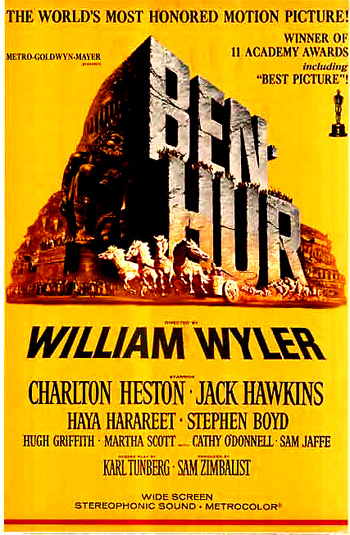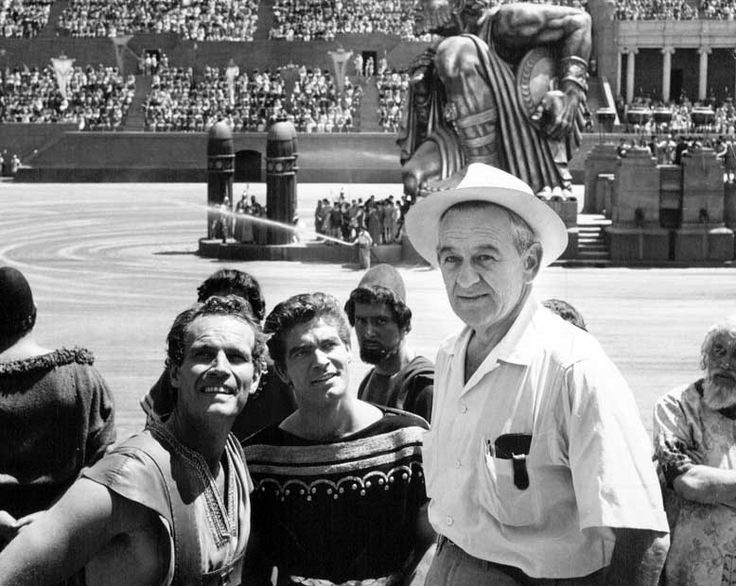William Wyler’s Ben-Hur (1959) is the definitive Biblical epic. It is the last of those lavish religious features of the fifties that were made to combat the rising popularity of television. Epics such as Quo Vadis (1951), The Robe (1952), and The Ten Commandments (1956) were created to be big enough and colorful enough to lure audiences back to their local cinemas.
Ben-Hur is the biggest of them all. Based on the 1880 novel from Lew Wallace, Ben-Hur is an expensive remake of the 1925 silent version, which itself is an expensive remake of a short film version from 1907.

As in the previous film, the story begins in Judea during the time of Jesus Christ when the Roman Empire was in the ascendancy. Judah Ben-Hur (Charlton Heston), a Jewish prince, meets his former childhood friend Messala (Stephen Boyd) who is the new tribune.
Messala lets Judah know that more legions of Romans will be arriving in Judea very shortly, but he promises Judah that he and his family will be safe.
After meeting Judah’s mother (Martha Scott) and sister Tirzah (Mary O’Donnell) at the house of Hur, Messala’s real intentions become known. He tries to force Judah to name any Jewish “troublemakers” so that they will be punished. Judah refuses Messala’s request and after an angry exchange, Messala leaves the house in disgust.
Ben-Hur’s servant Simonides (Sam Jaffe) and his daughter Esther (Haya Harareet) arrive with the caravan from Antioch. After reminiscing, Judah grants Esther permission to marry a servant in Antioch, offering her freedom from slavery as a wedding present. Judah promises to wear her slave ring until he gets married. Following a moment of tenderness, Esther leaves.
Later, Judah and Tirzah overlook the welcoming parade for the new Roman governor from the rooftop of their house. A loose tile falls off, barely missing the governor. Judah and Tirzah are accused of willfully attempting to injure the governor.
Despite knowing that Judah, his mother, and sister are innocent, Messala decides to arrest them anyway, using this moment to make an example of them. He sends Judah’s mother and sister to prison and sends Judah to the galleys, without even a trial.
Judah briefly escapes and finds his way into Messala’s chamber. Confronting Messala, Judah makes one promise to him just before he is dragged away by the Roman soldiers: “God grant me vengeance that you will live when I return!”
Ben-Hur was brilliantly directed by the acclaimed William Wyler, who had worked as an assistant in the 1925 version. Despite the huge production, Wyler was able to create a genuinely personal and intimate drama, yet containing the large screen excitements.
Costing a then-record figure of $15 million, Ben-Hur was an exceptionally expensive production to make. It was a huge and stressful undertaking that certainly contributed to the sudden death of producer Sam Zimbalist who was on location in Rome at the time.
Filmed by the celebrated cinematographer Robert L. Surtess, Ben-Hur is a visually stunning epic. Using a process called MGM Camera 65 which has an aspect ratio of 2.76:1, makes it one of the widest prints ever made. The width is almost three times its height.
Even the music score is extraordinarily epic. The impressively long opus by Hungarian-born film composer Miklós Rózsa is vast, sweeping, and very beautiful.
Although the set pieces such as the sea battle are well-staged, it is the memorable chariot race that is the highlight of the film. The race sequence took over three months to film, using 8000 extras on the largest movie set ever built, and is regarded as one of the most exciting action sequences ever filmed.
Assistant directors Andrew Marton and Yakima Canutt contributed significantly to the chariot race sequence. Future spaghetti western impresario Sergio Leone was also the senior assistant director.
Charlton Heston is well cast as Judah, winning an Academy Award for this performance, but Irish actor Stephen Boyd’s Golden Globe-winning performance as the evil Messala is often unfairly overlooked by many critics. In the 1925 version, Francis X. Bushman effectively stern in the role but it is difficult to accept that his Messala could have been Judah’s childhood friend. Boyd’s Messala is convincing.
According to the celebrated American writer Gore Vidal, who helped re-write Karl Turnberg’s screenplay, a mild gay subtext was added to suggest a much closer former bond between the two friends for a more immediate impact.

Israeli actress Haya Harareet plays Ben-Hur’s love interest Esther with delicate sensitivity and beauty, whilst British actor Jack Hawkins is convincing as the Roman warship commander Quintus Arius and American actor Sam Jaffe is excellent as Simonides.
Along with Vidal, Christopher Fry re-wrote the screenplay. Although it is credited as written by Karl Tunberg, Fry’s contribution was mentioned by Charlton Heston during his Best Actor Academy Award acceptance speech in 1960.
Ben-Hur earned a then-staggering $75 million at the box office, saving the MGM studios from almost certain bankruptcy. The film went on to sweep countless awards, including eleven Oscars with one for Best Picture, a record that was only equaled by Titanic (1997) and The Lord of the Rings: The Return of the King (2003).
There have been numerous other versions of Ben-Hur made, especially the rather poor 2016 remake from Kazakh director Timur Bekmambetov.
Fred Niblo’s 1925 film is still entertaining, but William Wyler’s 1959 version of Ben-Hur is easily the best version and the last of the big religious epics that Hollywood would soon find too expensive to produce.
